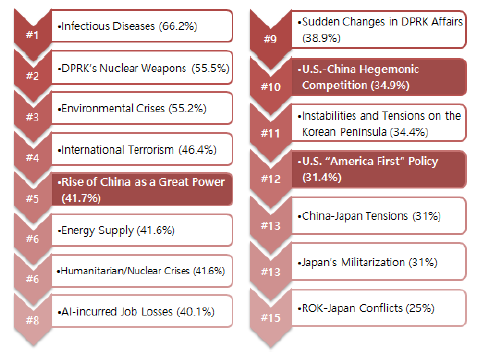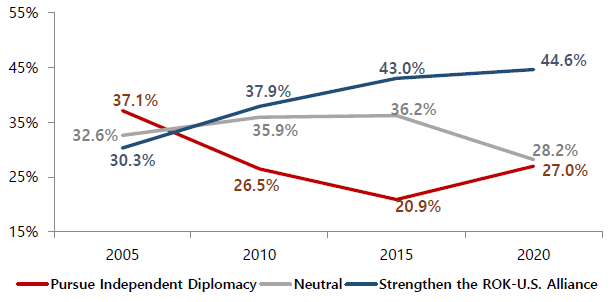[Issue Briefing] South Korean Perception of the United States and China: United States, a More Favorable Partner than China
Commentary·Issue Briefing | 2020-07-21
Sea Young Kim, Sook Jong Lee
Editor's Note
How does South Korea position itself amid rising U.S.-China competition in times of COVID-19? In the East Asia Institute (EAI)’s fourth South Korean Identity public opinion survey (May 2020), a general increase in hostile sentiments towards neighboring countries was revealed. Yet despite such developments, South Korea continues to display high affinity toward the U.S., which it views as a potential buffer and safeguard against the threat of rising China. Furthermore, while tensions have heightened between South Korea and the U.S. throughout the Moon and Trump administrations due to disagreements over defense cost sharing and the U.S. pursuit of the "America First” policy, South Korea increasingly desires to strengthen the ROK-U.S. alliance.
United States as More Favorable than China
As shown in Figure 1, South Koreans’ favorability levels of both the United States and China have decreased while negative sentiments have risen for both countries alike. However, the specific degree to which South Koreans’ sense of hostility has risen differs for the U.S. and China. While negative sentiments toward the U.S. increased by 5.4 percentage points (from 4.8% in 2015 to 10.2% in 2020) it has grown by 24 percentage points for China. In addition, though the level of affinity for the U.S. fell by 17.6 percentage points (from 77.3% in 2015 to 63.7% in 2020), over 60% of the respondents have retained positive feelings towards the U.S. On the other hand, the level of favorability for China has fallen by more than a half, with a 29.6 percentage point decrease (from 50% in 2015 to 20.4% in 2020). As a result, the percentage of hostility toward China has surpassed that of favorability since the 2015 survey.
Figure 1: South Korean Sentiments toward the U.S. vs. China (2015-2020)

The generational trend reflected in the affinity levels is also important, especially considering the future of South Korea’s bilateral relations with the U.S. and China. In addition to the generally favorable sentiment that South Koreans have of the U.S. and vice versa toward China, there is a large gap in how younger South Koreans see the U.S. and China (Figure 2). According to both the 2015 and 2020 surveys, South Koreans aged 18 to 29 have the most affinity toward the U.S. amongst the five age groups (82.6% in 2015 and 72% in 2020).
Figure 2: South Korean Sentiments toward the U.S. and China, by Age Group (2020)

The same group of young South Koreans, however, holds the largest hostility toward China (45.1% in 2020). This upsurge in anti-Chinese sentiment among the younger generation is noteworthy as South Koreans aged 18 to 29 had rated China’s favorability highest amongst the different age groups in the previous 2015 survey (52.7%) (Figure 3). Such an increase in South Korea’s hostile sentiment could be explained by China’s pressure and subsequent economic retaliation against South Korea during the years of 2015-2016 for the issue of deploying THAAD and the outbreak of the Wuhan originated COVID-19 pandemic since February 2020.
Figure 3: South Korean Sentiments toward China, by Age Group (2015)

United States as a Safeguard against the Threat of Rising China
For the questions addressing the risk factors for South Korea’s national interests in the next decade, respondents had the options of labelling the different categories as either “very threatening,” “somewhat threatening,” and “not a threat at all.” The percentage of responses for “very threatening” and “somewhat threatening” was then added to assess South Korea’s perceived priority national threats (Figure 4).
Figure 4: Top Perceived Threats to South Korea's National Interests for the Next Decade (2020)

Other than “Infectious Diseases”(66.2%), which surpassed “North Korea’s Nuclear Weapons” as the top national threat for the first time due to the COVID-19 pandemic, “Rise of China” continues to rank among the top five listed risk factors to South Korea’s national interests. In fact, the number of respondents who identified it as either “very threatening” or “somewhat threatening” has increased by 2.7 percentage points since 2015 (from 39% in 2015 to 41.7% in 2020). South Korea’s perception of China as a threat has also been echoed in previous EAI surveys. For example, in the Seventh Korea-Japan Public Opinion Survey conducted in May 2019 (hereafter, the May 2019 survey) administered by both EAI and The Genron NPO, China followed North Korea as the number two country of threat to South Korea. In another EAI survey on the Mid-term Assessment of the Moon Jae-in Administration from November 2019 (hereafter, the November 2019 survey), 66.9% of the respondents also identified China’s rise as a threat rather than as an opportunity (22.6%) for South Korea.
How do South Koreans, then, view the United States in comparison to China? Although 31.4% of the respondents have identified “U.S. ‘America First’ Policy” (a newly added category for the 2020 survey) as a threat (Figure 4), the overall view that South Koreans have of the U.S. is that it is a strategic buffer against China. For example, in the same survey from November 2019, 60.1% of the respondents agreed that the ROK-U.S. alliance helps to protect South Korea from China’s economic and diplomatic pressure compared to 34.5% who disagreed.
While an increased number of South Koreans feel that “U.S.-China Hegemonic Competition” is a national threat (from 24.4% in 2015 to 34.9% in 2020) (Figure 3), more South Koreans would rely on the U.S. than on China in facing rising tensions between the two countries (Figure 5). Aside from the fact that two out of three South Koreans have voted in favor of taking a “balanced approach” toward both the U.S. and China, more respondents opted to “strengthen relations with the United States” (24.9%) than “strengthen relations with China” (11.1%). The trend is also rising for those in favor of the U.S. (from 22.7% in 2015 to 24.9% in 2020) whereas it has fallen for China (from 13.1% in 2015 to 11.1% in 2020). In the aforementioned November 2019 survey, a similar trend was observed in which the number of respondents who answered that they would support the U.S. (24.4%) in the case of U.S.-China tensions exceeded those in support of China (5.1%) by nearly five folds.
Figure 5: Position South Korea Should Take in U.S.-China Hegemonic Competition (2015-2020)

Increased Desire to Strengthen the ROK-U.S. Alliance
South Koreans continue to desire the strengthening of the existing alliance with the United States (Figure 6). Since the Korean Identity survey was first administered in 2005, the percentage of respondents opting for the strengthening of the ROK-U.S. alliance has continuously risen by 14.3 percentage points (from 30.3% in 2005 to 44.6% in 2020). While more South Koreans prefer the pursuit of independent diplomacy in 2020 than in 2015 (from 20.9% in 2015 to 27% in 2020), the gap between the percentage of respondents supporting the bilateral alliance (44.6%) versus independent diplomacy (27%) is still significant by 17.6 percentage points.
Figure 6: Desirable Relations with the United States (2005-2020)

Meanwhile, China continues to rank first as the country expected to influence South Korea the most in the next decade among five countries including the U.S., Japan, Russia and North Korea. This could be explained by the economic significance China holds as South Korea's largest trading partner of 162 billion USD, followed by the U.S. at 73 billion USD (World Bank, 2018). In the 2020 survey, South Koreans selected "development as an economic power” as the number one long-term future policy agenda (with 28% of the respondents) among thirteen policies, which emphasizes China's importance as a leading economic partner for South Korea. Similarly, in the May 2019 survey, 83.9% of the respondents selected China as a more important economic partner for South Korea compared to the U.S. (72.6 %).
Figure 7: Country Expected to Influence South Korea the Most in the Next Decade (2005-2020)[1]

Although China is an important trade partner for South Korea, the number of respondents seeing it as the most influential country for South Korea has decreased since 2015 by 18.5 percentage points (from 72.1% in 2015 to 53.6% in 2020). On the other hand, the perception of influence that South Koreans have of the U.S. has risen by 17 percentage points (from 13.3% in 2015 to 30.3% in 2020). In the May 2019 survey, there had also been a 4.4 percentage point increase in the number of respondents who had selected that U.S. regional influence would rise in the next decade (from 30.5% in 2018 to 34.9% in 2019). Only a tenth of the respondents (9.1%) predicted that U.S. power would diminish within the same survey.
Conclusion
Despite existing tensions between South Korea and the U.S., the 2020 Korean Identity survey shows that the ROK-U.S. alliance continues to hold significance to South Korea as a safeguard against the threat of rising China. The bilateral alliance between the two countries extends beyond security and economic means, as more than half of the respondents in the November 2019 survey (51%) stated that the alliance is natural given the shared values between the two countries (compared to 33.8% of the respondents who disagreed).
The importance that South Koreans place upon the ROK-U.S. alliance exceeds beyond the difficulties that the nation faces as a middle power caught amid rising U.S.-China hegemonic competition. In the November 2019 survey, 70.9% disagreed that the importance of the ROK-U.S. alliance would be reduced if the U.S. power declines more than that of China within the region.
As mentioned in "ROK-US Cooperation in an Era of US-China Strategic Competition” (Lee, 2019), the U.S. needs to take this opportunity to be "prudent and patient” in addressing South Korea even if the domestic public opinion in South Korea remains largely in favor of the U.S. With 31.4% of the respondents identifying the Trump administration's "America First” policy as a national threat, anti-American sentiments will arise and weaken domestic support for the ROK-U.S. alliance if the U.S. demands extensive economic commitments from South Korea toward the alliance and threatens to withdraw the U.S. force from the Korean Peninsula. ■
press coverage
Trump’s South Korea bashing doesn’t strengthen Xi
■ Sea Young Kim is a research associate and project manager at the East Asia Institute. Her recent publication includes "New North-Southeast Asia Security Links: Defending, Recentring, and Extending Regional Order” (Australian Journal of Politics and History, 2019).
■ Sook Jong Lee is a Senior Fellow and Trustee at the East Asia Institute and served the Institute as President from 2008 to 2018. She is also a professor of public administration at Sungkyunkwan University. Her recent publications include Transforming Global Governance with Middle Power Diplomacy: South Korea’s Role in the 21st Century (ed. 2016), Keys to Successful Presidency in South Korea (ed. 2013 and 2016), Public Diplomacy and Soft Power in East Asia (eds. 2011).
■ Typeset by Sea Young Kim, Research Associate/Project Manager
For inquiries: 02 2277 1683 (ext. 208) | sykim@eai.or.kr
The East Asia Institute takes no institutional position on policy issues and has no affiliation with the Korean government. All statements of fact and expressions of opinion contained in its publications are the sole responsibility of the author or authors.
![[ADRN Issue Briefing] Prospects for Democracy Amidst Two National Elections in Sri Lanka](/data/bbs/eng_issuebriefing/2024101893733190656022(0).jpg)
Commentary·Issue Briefing
[ADRN Issue Briefing] Prospects for Democracy Amidst Two National Elections in Sri Lanka
Bhavani Fonseka | 2020-07-21